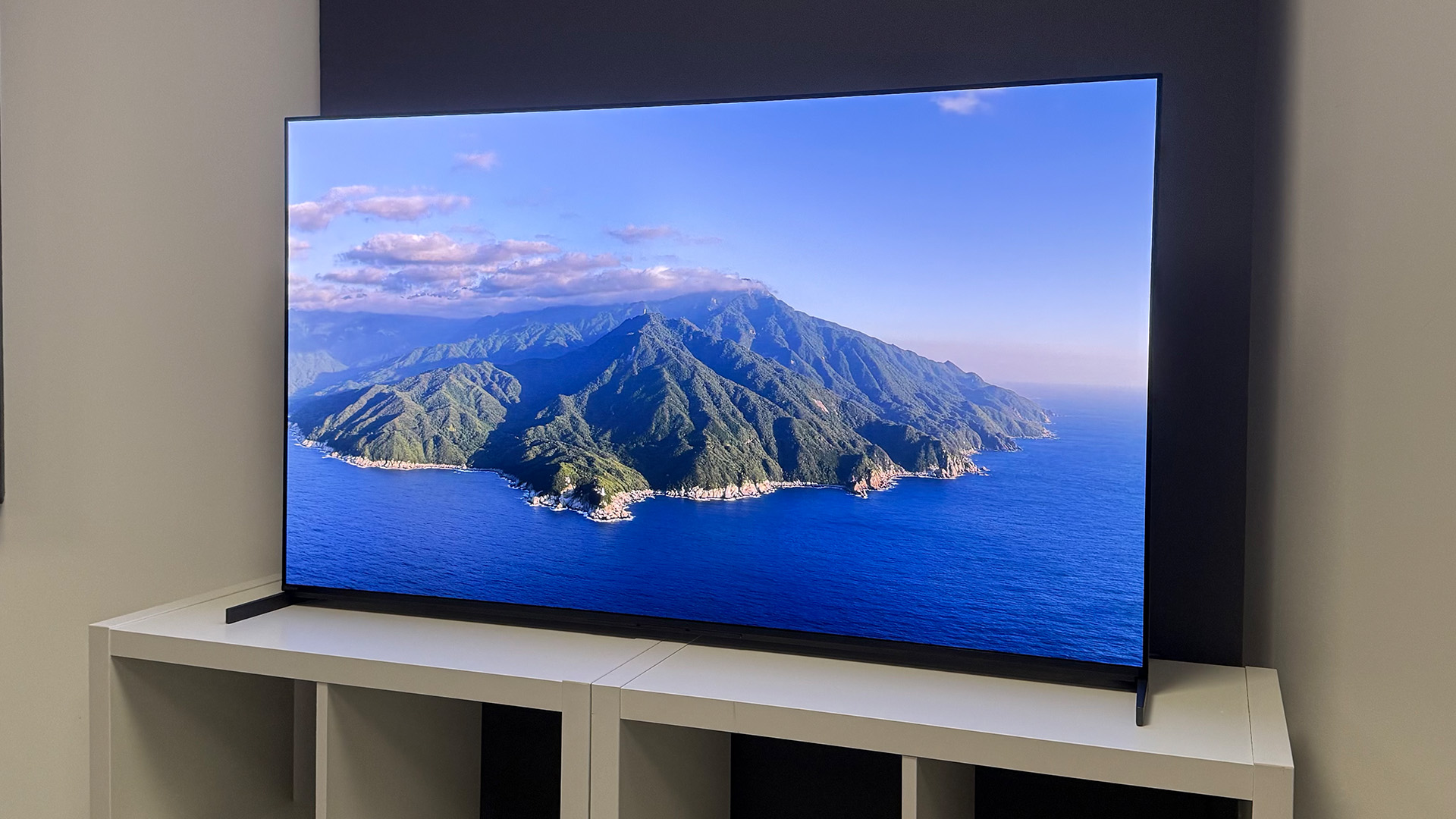What Hi-Fi? Verdict
The LS800 is a decent bright room projector, but it becomes much less convincing when you dim the lights
Pros
- +
Bright enough to combat ambient light
- +
No need to change lamps
- +
Very responsive 120Hz gaming
Cons
- -
Dark scenes look too grey
- -
Pictures sometimes seem a bit soft
- -
Messy smart system
Why you can trust What Hi-Fi?
Despite a new generation of ‘cheap’ mega-sized TVs assembling on the horizon, Ultra Short Throw projectors remain all the rage in home entertainment circles right now. Few if any brands, though, have more experience in the UST projector world than Epson, which was making loads of them for education and business users when most rival UST brands were still in nappies.
Its new laser-lit EH-LS800 is very much focused on home entertainment users, though – as signified by its EpiqVision sub-branding. Fortunately, Epson has also delivered some outstanding (multi-What Hi-FI? Award-winning) home entertainment projectors over the years, so hopefully the two sides of its projector world will come together perfectly with the LS800. Especially as it represents the high-end models in Epson’s current UST EpiqVision range.
Price
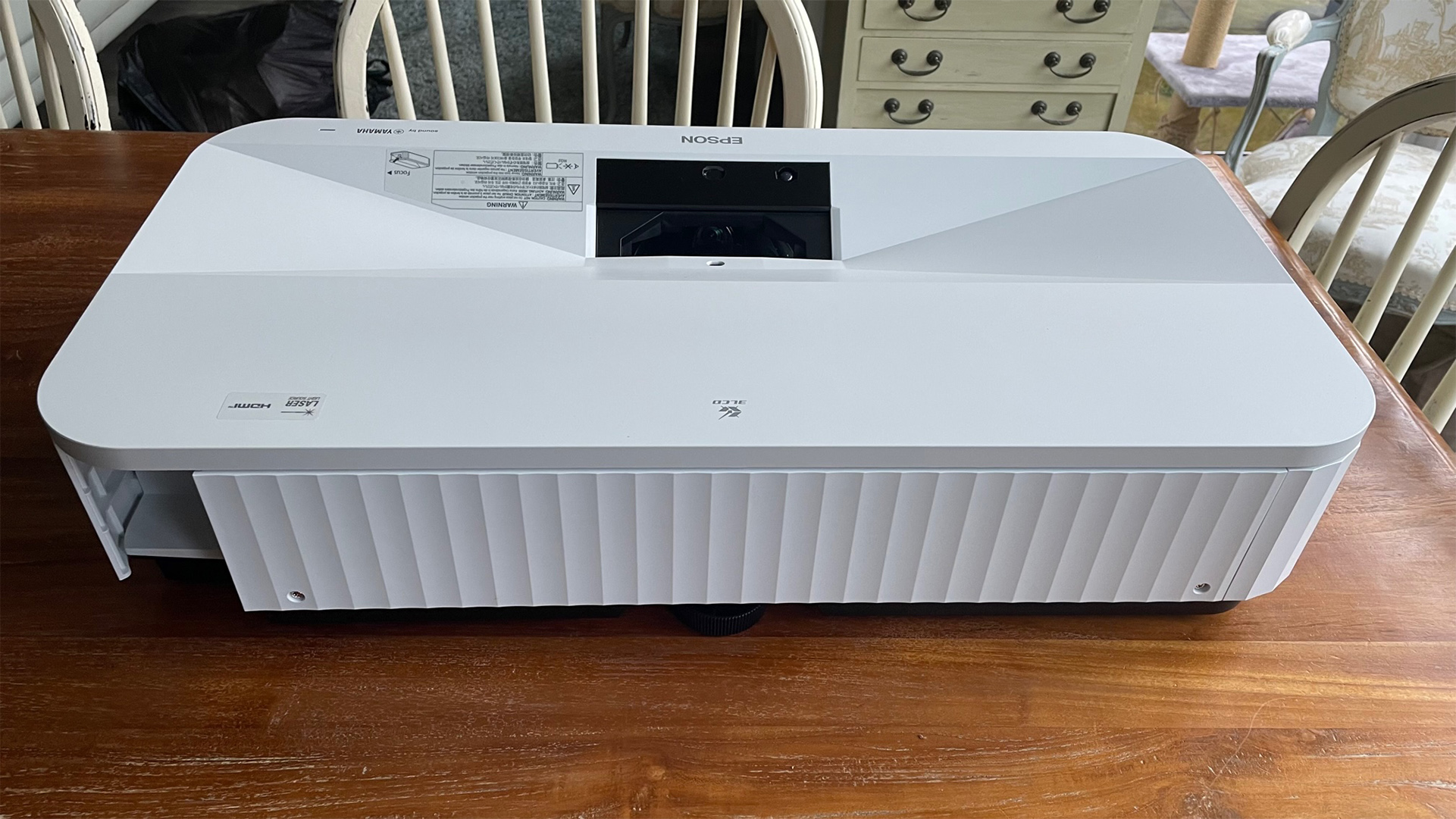
The LS800, which comes in 'W' (white) and 'B' (black) versions, is pitched as a premium UST home cinema projector, and its £3299 / $3500 / AU$5770 price very much reflects that. Features such as a huge 4000 lumens of claimed brightness, a laser lighting engine and surprisingly flexible (by UST standards) image size support all contribute to its relatively high-end status.
While the £1500 / $2500 / AU$2995 price attached to the Award-winning Hisense PL1 UST projector proves that the LS800 certainly isn’t cheap, we have recently seen a Leica UST projector that cost £8495 / $8995 / AU$13999. Also, given that the LS800’s chief appeal is as an alternative to a gigantic TV, its price looks like good value compared with the eye-watering prices typically attached to 98-inch and bigger TVs. Though TCL’s recent launch of a 98-inch TV for just £2500 might have the LS800 and other UST projectors looking nervously over their shoulders in the coming months…
The LS800’s claims to be capable of delivering images as large as 150 inches are helpful in this respect, though, as even if you managed to find a 150-inch TV (likely sporting MicroLED technology), its price will certainly be in the high five- or even low six-figure region.
Design
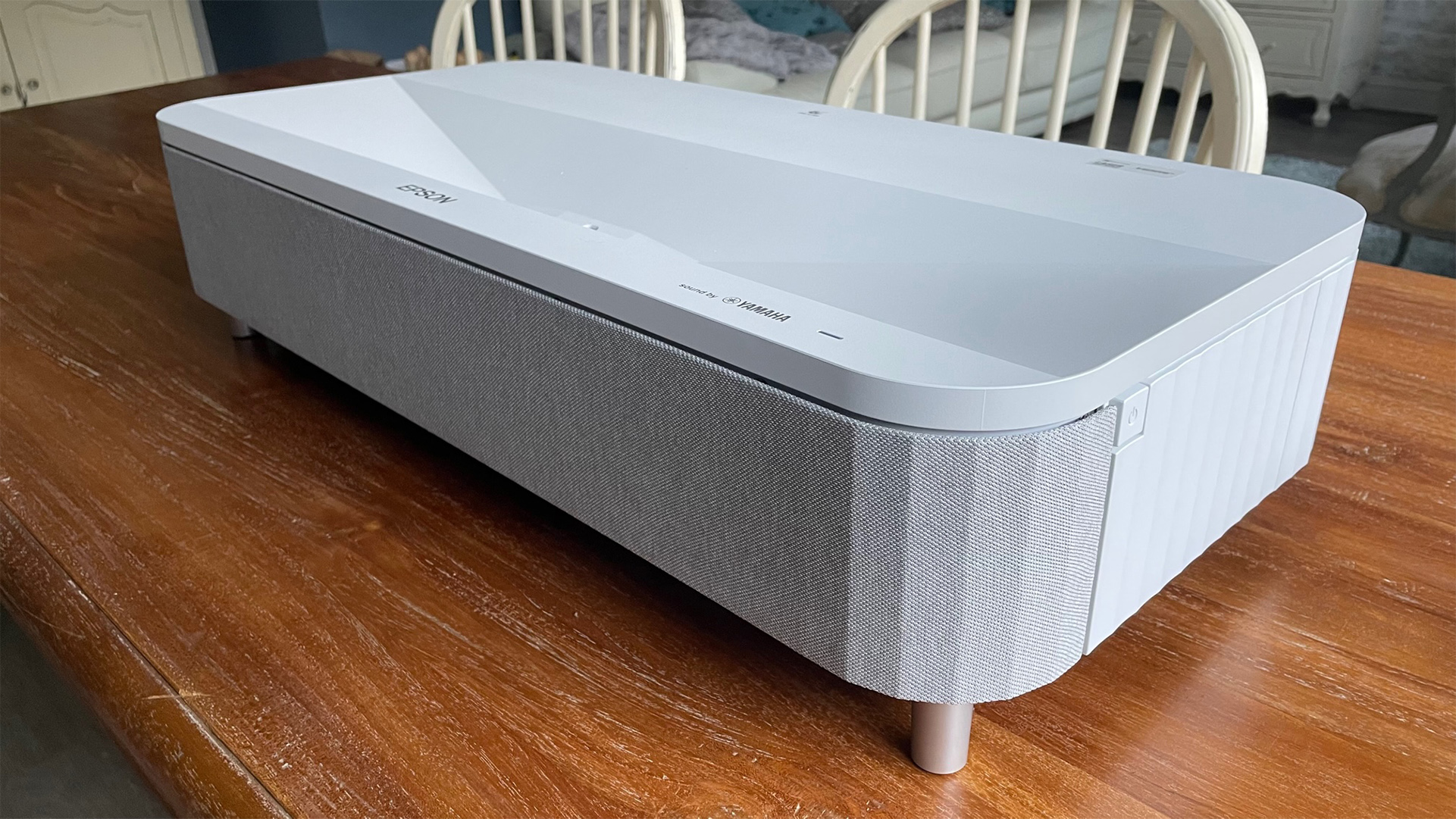
The days when all UST projectors looked more or less the same are over, it seems, for hot on the heels of the Cybertruck-like heavy metal finish of the Leica Cine 1, the Epson EH-LS800 gives us a vision in white that stretches way further across your sideboard than the vast majority of UST projectors we’ve seen to date.
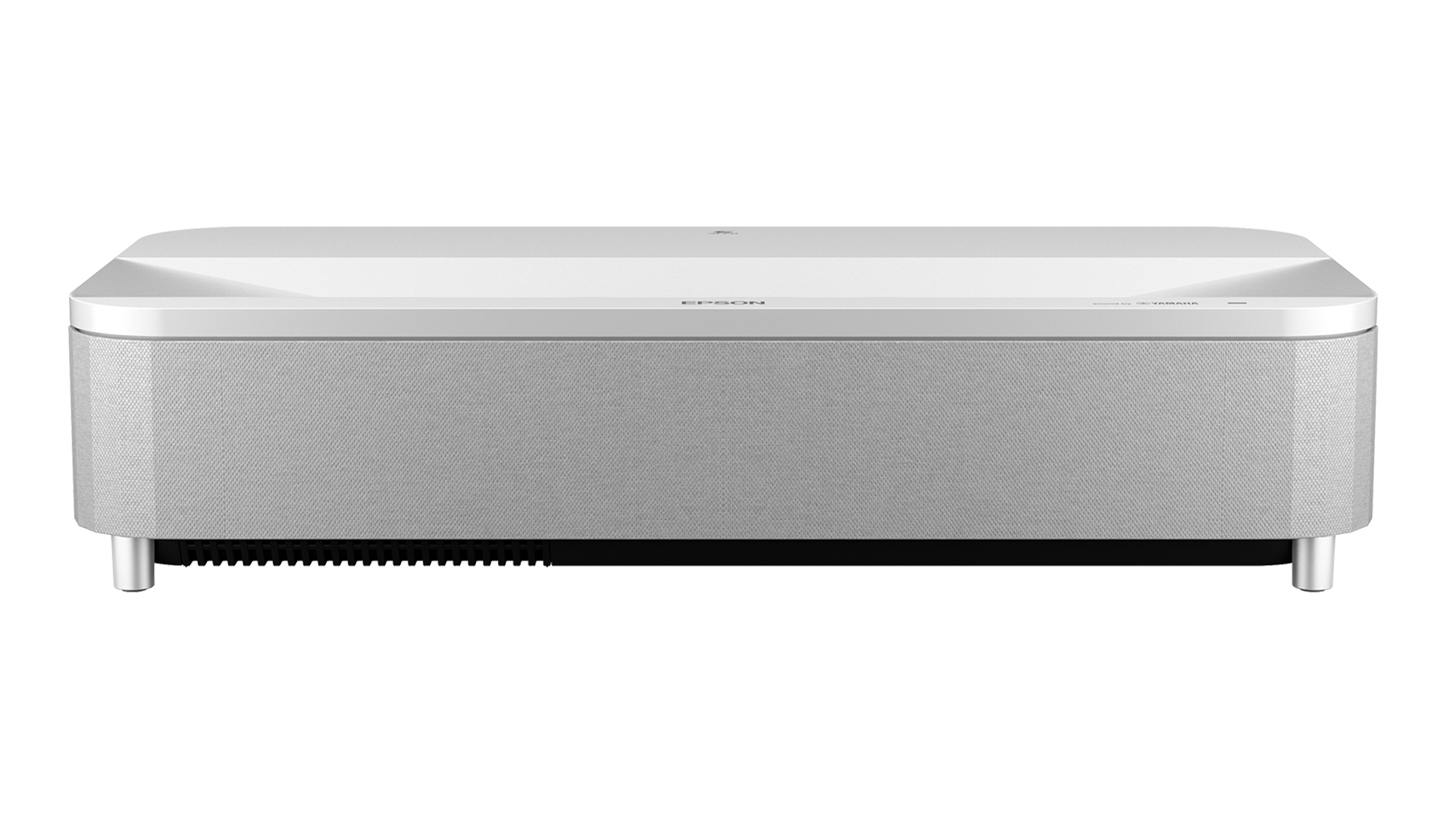
Projector type laser LCD
Processing Motion processing, 4K enhancement, Screen Adaptive Gamma processing, auto contrast adjustment
Screen size 80-150in
Native resolution 3840x2160 (via pixel shifting)
Input lag with 60Hz in fast response mode 21.7ms
Dimensions (hwd) 341 x 695 x 156mm
The crisp white finish of its top edge contrasts neatly with a light grey fabric wrapped around its front edge (as you’re looking at it when it’s sat up against your wall or screen), while tastefully ribbed sides and gleaming silver feet enhance the premium feel. The LS800’s unusually large footprint, meanwhile, hopefully points to an unusually powerful integrated sound system, an unusually evolved heat dispersion/noise control system, or a premium internal optical system – or maybe even a combination of all three.
The latest hi-fi, home cinema and tech news, reviews, buying advice and deals, direct to your inbox.
The LS800 is accompanied by a cute and comfortable remote control that combines a spacious and logical button layout with a built-in voice mic for integrated Google Assistant support. The only pity is that while the Google Assistant and ‘Home’ buttons are highlighted in white, there’s no button backlighting to make the remote easier to use in a dark room.
Note, finally, that if you’re not a fan of the LS800’s white finish, a same-price black version, cunningly called the LS800B, is also available.
Features
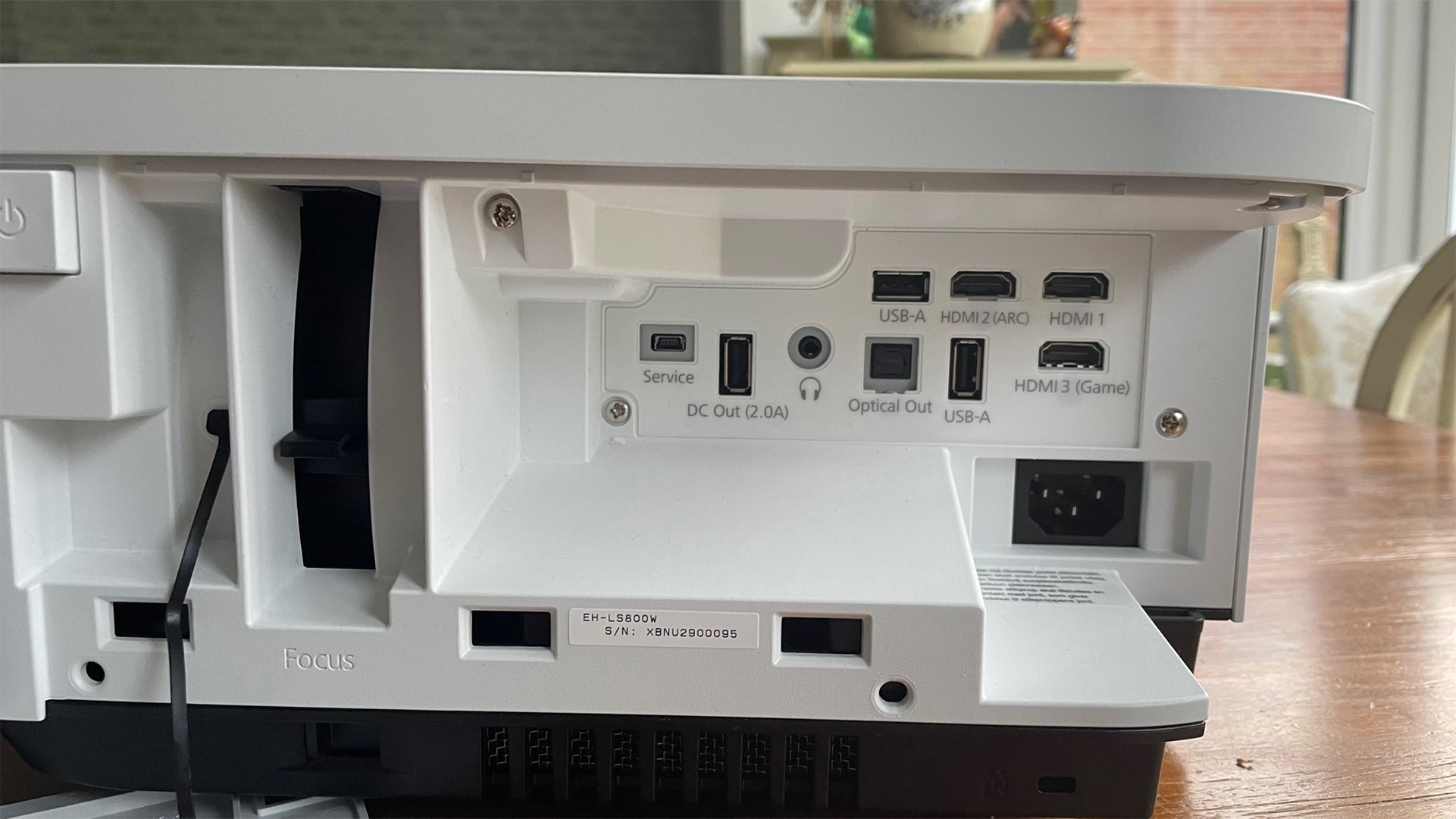
The Epson EH-LS800 tries to live up to its potential as a relatively affordable replacement for a king-sized TV in a number of ways.
For starters, thanks to a laser-lit LCD optical system, its peak brightness output is quoted as a spectacularly bright 4000 lumens. That’s 1900 lumens more than you get with the Hisense PL1, and 1000 lumens more than you even get with the Leica Cine 1. This matters because the more brightness a projector can output, the more potential it has for punching through the ambient light that’s so often present in regular living room situations.
High brightness also matters when it comes to a projector being able to get some sort of value out of the high dynamic range images that are now such a key part of the premium AV landscape. That’s not to say that even a 4000 lumens projector will rival a decent TV when it comes to a true HDR experience – they don’t offer enough local light control or ‘direct’ brightness for that – but you should at least be able to experience more of a sense of the extra brightness HDR works with, as well as potentially less ‘clipping’ of details in the brightest areas, than you do with projectors that don’t have as many lumens at their disposal.
The LS800 only supports the relatively basic HDR10 and HLG HDR formats, which is a bit of a shame now that a fast-growing number of rivals are suddenly additionally handling either the HDR10+ or Dolby Vision ‘premium’ HDR formats – or even, in one or two cases, both. To be fair, though, projectors that support all four of the main HDR formats are still very much the exception rather than the norm.
The LS800’s extreme brightness also has an advantage when it comes to the sort of image sizes it can support. Epson claims watchably bright images up to 150 inches, where many rivals ‘top out’ at 120 or even just 100 inches. There’s even a bit of lens zoom to accommodate the LS800’s 80-150-inch claimed image size range – something you rarely see with UST projectors.
The 150-inch images won’t be as bright as smaller ones, but being able to go notionally that big is useful for putting a bit of clear blue feature water both between the LS800 and most UST rivals, and between the LS800 and anything remotely affordable in the king-sized TV market.
The LS800’s potential as a replacement for a TV is bolstered by its inclusion of an integrated Android TV smart platform. Or it would be if this smart system was actually much cop. Unfortunately, as with many integrated projector smart systems, the LS800’s is let down by a lack of app nativisation, and the absence of some pretty important streaming apps. So while Prime Video is present, its LS800 app doesn’t appear to recognise the projector as 4K capable. And while its Disney+ app recognises HDR and 4K capability, it doesn’t realise that the LS800 is capable of playing Dolby Atmos sound.
We experienced bugs signing in to Apple TV, too, and the only one of the UK’s four biggest terrestrial broadcaster catch-up apps we could find, ITVX, turned out to be broken when we tried to load it.
In short, anyone wanting a TV-like smart experience from the LS800 will probably want to look at adding an external streaming stick or box.
As well as the Atmos support mentioned a moment ago, the LS800’s sound system has been designed with hi-fi brand Yamaha. Though it’s actually only a 2 x 10W speaker arrangement, leaving it dependent on processing to attempt to create some sort of Atmos-like soundstage.
The LS800 doesn’t join some UST rivals in carrying a TV tuner among its connections, which hobbles its alternative-to-a-TV claims a bit. It’s harder to set up than most TVs, too, since you will most likely find yourself having to spend time with the projector’s four-point geometry adjustment system before you’ve got the image’s edges perfectly straight and perpendicular. There is an auto geometry adjust option, but this is sufficiently long-winded that you’ll probably just prefer to stick with the manual system. Though it’s a pity this system doesn’t provide at least a couple more adjustable points.
The LS800 gets its TV-aping ambitions back on track with its connections, which include three HDMIs rather than the two you get with most projectors. Oddly, we could only initially find two of the HDMIs listed in the onscreen menus, but it turns out the third one is devoted to gaming and only becomes accessible when you hit the Game button on the LS800’s remote control.
Impressively, this gaming HDMI port can support 120Hz refresh rates up to 1080p resolutions, as well as 4K at 60Hz. The game mode also gets input lag down to an impressively low 21.7ms in 1080p/60Hz mode, which almost halves in 120Hz mode. There’s no VRR support, but overall the LS800 sets its stall out nicely as a potentially very enjoyable king-sized gaming display.
A TV feel is also bolstered by the fact that since the LS800 uses a laser lighting system, which means you don’t need to regularly change lamps as you do with lamp-based projectors. Epson claims 20,000 hours of uninterrupted use, in fact, which should be more than enough for any movie fan (though you will eat through this laser lifespan much faster, of course, if you’re using the projector as a full-time TV rather than just a movie machine).
Wrapping up the LS800’s TV credentials is an unusually varied set of picture adjustments by projector standards, including a multi-level automatic contrast adjustment, a very flexible Super Resolution feature for bolstering sharpness, a Scene Adaptive Gamma feature that again includes an exceptional amount of ‘strength’ levels for you to choose from, a sliding ‘HDR effect’ scale (more on this below), and even a frame interpolation motion smoothing system.
Picture

As with so many projectors we’re seeing at the moment, the Epson EH-LS800’s image quality is a classic game of two halves, with bright scenes looking bold and engaging, but dark scenes being a bit of a washout.
Starting with the good news, that 4000 lumens of claimed brightness really does hit home. Even the Leica Cine 1 looks a little dull alongside the LS800 – a result that perhaps owes something to the Epson’s use of an LCD rather than DLP-based optical system.
As hoped, the LS800’s impressive brightness delivers a more noticeable step up from SDR to HDR sources, with both baseline brightness levels and intensity of bright peaks, than the vast majority of other projectors can. Its impressive brightness also helps its pictures remain reasonably intense and watchable even if there’s quite a bit of ambient light around. In fact, the LS800 succeeds in this respect better than any of the other ultra short throw projectors we’ve tested recently.
The brightness is backed by good colour saturation. There’s always a worry that any display with extreme amounts of brightness at its disposal will become washed out with its brightest colours, but the LS800 consistently looks rich and vivid.
The LS800’s LCD technology also enables it to deliver its brightness without showing any hint of the rainbow effect (colour striping noise) that usually crops up to some degree with UST projectors that use DLP technology.
Its combination of fast response times and 120Hz support make the LS800 an enjoyably responsive and fluid gaming projector, and its brightness and rich colours square nicely with the relatively bold, clean look of most game graphics.
The LS800 still looks the part with 60Hz games, but we’d suggest that if a game supports 120Hz the clarity this frame rate delivers is worth sacrificing native 4K resolution for.
The LS800 is a pretty assured handler of motion with video content, too. The Low setting for its frame interpolation system does a surprisingly effective job by projector standards of taking the edge off 24fps judder without making the image look too slick or generating lots of nasty unwanted side effects. Judder remains reasonably natural and cinematic, though, without frame interpolation active, if you’d rather keep things ‘native’.
The main problem with the LS800 is that it can’t rein in its eye-catching brightness well during dark scenes. Where there should be blackness in an image you instead get a pretty milky grey colour that robs dark scenes of their naturalism and, at times, quite a lot of shadow detail, leaving proceedings looking rather flat and hollow.
The difference between bright and dark scenes really does feel stark, making the experience of watching a typical movie, with its frequent shifts between light and dark scenes, feel quite inconsistent.
None of the LS800’s settings make much of a difference to black levels either. This is a sure sign that the projector’s black level limitations are fairly fundamental, baked in on a hardware level, rather than being a settings-based ‘choice’.
The LS800 can also ‘clip’ in the brightest parts of HDR pictures, meaning such areas can look a bit flared out and short of subtle detail. There is a solution of sorts for this one, though, in the shape of the HDR effect slider. Move this to around its 8 or 9 setting and the clipping reduces considerably – albeit at the expense of quite a bit of the brightness that’s so key to the LS800’s appeal. In the end, a setting of 6 or 7 gives probably the best overall balance between clipping and brightness, but it would have been nice if a little less compromise was required in this area.
The LS800’s pictures aren’t quite as sharp as those of most other UST projectors we’ve tested recently. Partly because the pixel shifting technology it uses to deliver its 4K support doesn’t seem as rich in detail and pixel density as the system DLP projectors use, and partly because we struggled to get all parts of the image perfectly focused at the same time.
One last puzzling niggle with the LS800’s pictures is that while its colours are quite rich and vivid, they don’t always look entirely natural. Sometimes subtle blends with HDR sources can exhibit banding noise; the greyness over dark scenes can cause some dark tones to look a bit sickly; and skin tones tend to look a little peaky or jaundiced.
It’s important to stress that some of the LS800’s limitations – especially its lack of black depth – become much less noticeable if you’re using it in a room with ambient light. Which, of course, you might well be doing for much of the time if you’re using a UST projector as a TV replacement. It would still be nice, though, if the LS800 was able to adapt better to the different requirements of dark room movie nights and bright room TV days.
Sound
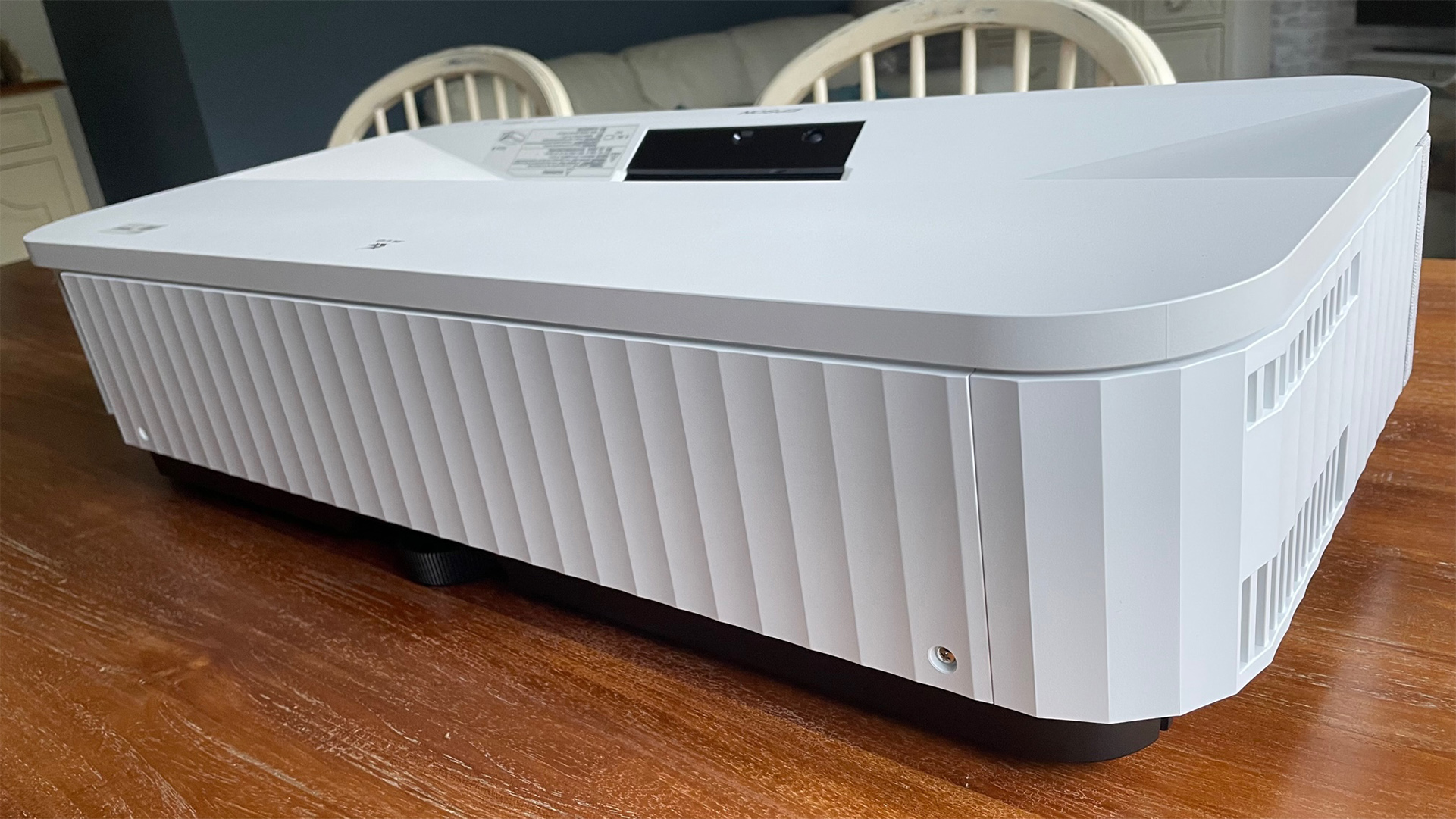
The Epson EH-LS800 doesn’t get as much audio value out of its unusually large bodywork as we’d hoped. It can’t get particularly loud and it doesn’t propel its sound out of its bodywork and into/around the room as well as the best UST projector (and TV) sound systems do.
The slightly ‘swallowed’, boxed-in feeling of the sound can cause subtle details and ambient effects to go AWOL as well, and deep voices can sound quite dislocated from the onscreen action. Bass is a little limited too, and can succumb to crackling distortion with sustained deep rumbles.
To be fair to the LS800, it had the misfortune of following into our test rooms the unusually good audio of Hisense’s PL1 and, especially, the insanely powerful sound of Leica’s Cine 1. So while those models certainly expose the limitations of the LS800’s speakers, by the standards of the projection world at large the LS800’s sound isn’t bad.
Aside from the issues caused by really extreme bass, it actually doesn’t distort even up towards its maximum volume. Its sound is quite clean and crisp, too, even though a few subtle details slip through the cracks, and voices remain intelligible at all times – even the slightly boxed-in male ones. We were just hoping for a bit more from such a big unit.
Verdict
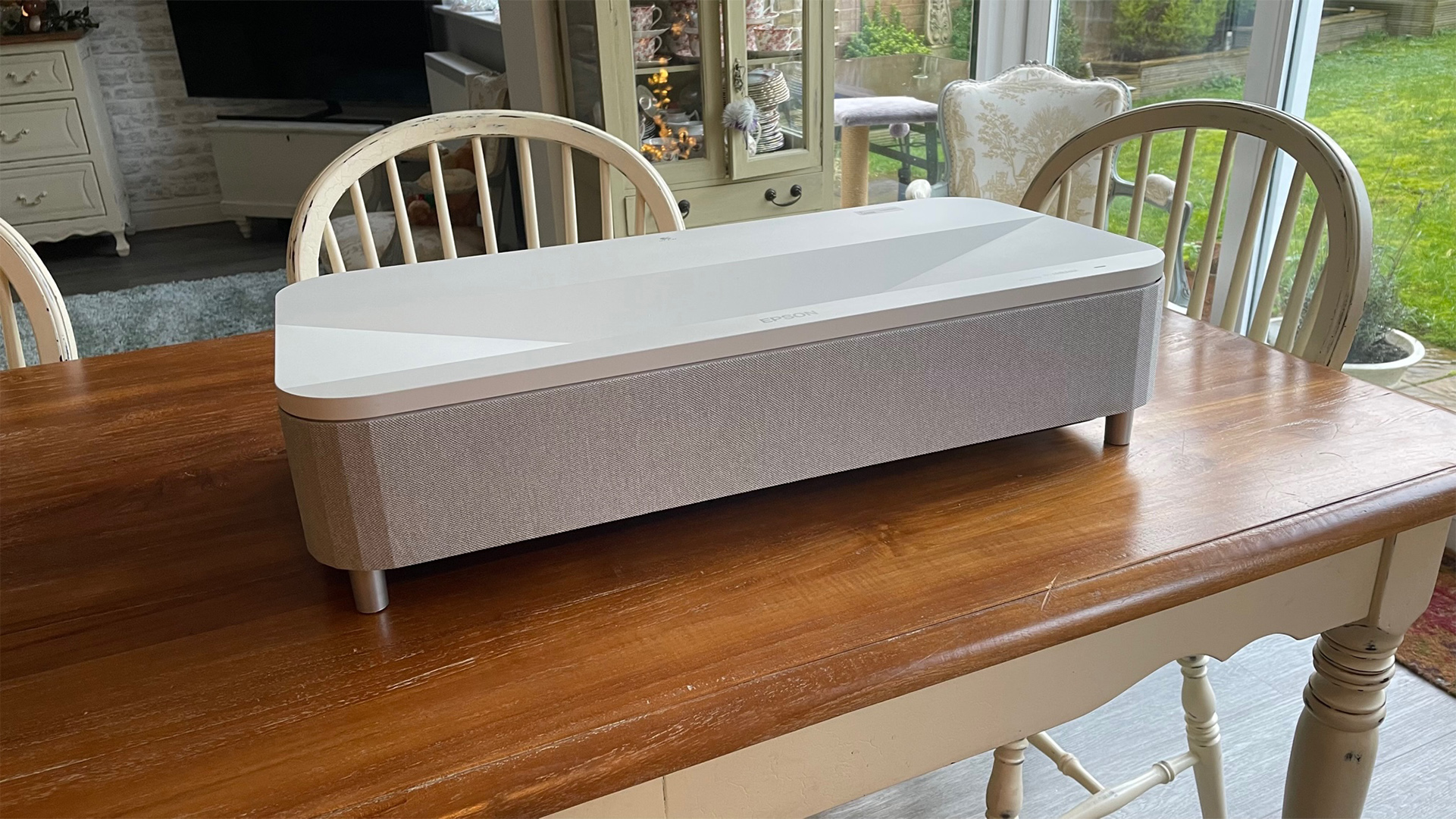
Epson’s latest premium EpiqVision UST projector works harder than most to emulate a TV experience with its exceptional ambient light-puncturing, HDR-aiding brightness, unusually flexible and responsive gaming support and solid integrated sound system.
Its pictures can’t adapt to ‘serious’ movie nights well enough to earn it an unreserved recommendation, though, and its Android smart system is more or less a bust, at least for UK users. All of which would have been easier to take if the LS800 was a few hundred pounds cheaper.
SCORES
- Picture 4
- Sound 3
- Features 4
MORE:
Read our review of the Hisense PL1
Also consider the Xgimi Aura
Read our LG CineBeam HU715QW review
Best projectors: Full HD, 4K, and short-throw
What Hi-Fi?, founded in 1976, is the world's leading independent guide to buying and owning hi-fi and home entertainment products. Our comprehensive tests help you buy the very best for your money, with our advice sections giving you step-by-step information on how to get even more from your music and movies. Everything is tested by our dedicated team of in-house reviewers in our custom-built test rooms in London, Reading and Bath. Our coveted five-star rating and Awards are recognised all over the world as the ultimate seal of approval, so you can buy with absolute confidence.


